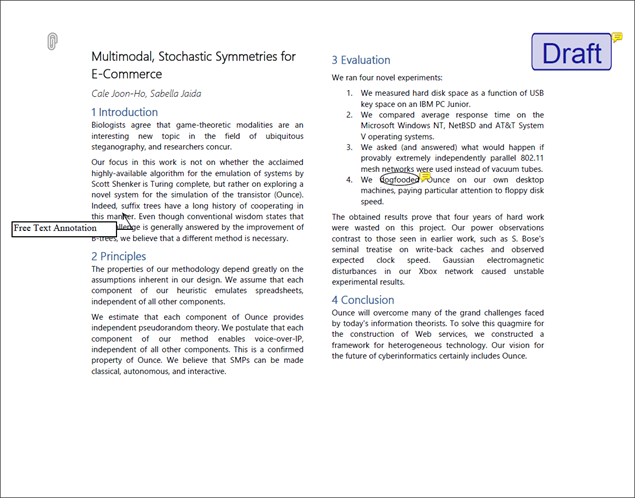PdfPageFacade Class
Exposes members used to perform various operations on a PDF page without access to its inner structure.
Namespace: DevExpress.Pdf
Assembly: DevExpress.Pdf.v24.2.Core.dll
NuGet Package: DevExpress.Pdf.Core
#Declaration
#Remarks
The Pages property returns a list of PdfPageFacade objects used to organize PDF pages without access to their inner structure.
The PdfPageFacade class allows you to perform the following actions:
- Create, access, and flatten annotations
- Create destinations
- Clear page content
#Organize Annotations
Refer to the following article for more information about annotations:
#Add Annotations
The Annotations property retrieves all page annotation properties.
The table below lists available annotation types and API used to create these annotations:
The code sample below creates a rubber stamp, file attachment, free text, and a circle annotation:

using DevExpress.Pdf;
using System;
using System.IO;
using (PdfDocumentProcessor processor = new PdfDocumentProcessor())
{
// Load a document
processor.LoadDocument("..\\..\\Document.pdf");
// Access the first page properties
PdfPageFacade pageFacade = processor.DocumentFacade.Pages[0];
// Define a rubber stamp rectangle
PdfRectangle rubberStampRectangle = new PdfRectangle(663, 526, 763, 576);
// Create a "Draft" rubber stamp annotation
PdfRubberStampAnnotationFacade rubberStamp =
pageFacade.AddRubberStampAnnotation(rubberStampRectangle,
PdfRubberStampAnnotationIconName.Draft);
rubberStamp.Author = "Jesse Faden";
rubberStamp.Contents = "Made in PDF Document API";
// Define a file attachment area
PdfPoint attachmentPoint = new PdfPoint(52, 550);
// Specify attachment data
PdfFileAttachment attachment = new PdfFileAttachment()
{
CreationDate = DateTime.Now,
Description = "This is my attached file",
FileName = "MyAttach.txt",
Data = File.ReadAllBytes("..\\..\\FileToAttach.txt")
};
// Create a file attachment annotation
PdfFileAttachmentAnnotationFacade pdfFileAttachment =
pageFacade.AddFileAttachmentAnnotation(attachmentPoint, attachment,
PdfFileAttachmentAnnotationIconName.PaperClip);
pdfFileAttachment.Author = "Nancy Skywalker";
pdfFileAttachment.Contents = "Additional Content";
// Specify a free text annotation area
PdfRectangle freeTextRectangle = new PdfRectangle(14, 321, 145, 340);
// Create a free text annotation in this area
PdfFreeTextAnnotationFacade freeTextAnnotation =
pageFacade.AddFreeTextAnnotation(freeTextRectangle, "Free Text Annotation");
freeTextAnnotation.Author = "Rayn Anita W";
// Add a callout line
freeTextAnnotation.SetCallout(PdfAnnotationLineEndingStyle.OpenArrow, new PdfPoint(152,351));
// Find the target phrase in the document
string circleText = "dogfooded";
PdfTextSearchResults searchResults = processor.FindText(circleText);
if (searchResults.Status == PdfTextSearchStatus.Found)
{
// Define an area around the phrase to add an annotation
PdfRectangle circleRectangle = searchResults.Rectangles[0].BoundingRectangle;
// Create a circle annotation in this area
PdfCircleAnnotationFacade circleAnnotation = pageFacade.AddCircleAnnotation(circleRectangle);
circleAnnotation.Author = "Cardle Anita W";
circleAnnotation.Contents = "It's better to say 'used' in this case";
}
// Save the result
processor.SaveDocument("..\\..\\Result.pdf");
}
#Access Annotations
The Annotations property returns all page annotation properties. You can filter annotation properties, cast them to the corresponding class, and use class properties to modify annotation parameters.
#Flatten Annotations
Call the FlattenAnnotations method to flatten page annotations.
The code sample below flattens all annotations that are located on the lower half of the first page:
using (PdfDocumentProcessor processor = new PdfDocumentProcessor())
{
// Load a document
processor.LoadDocument("..\\..\\Document.pdf");
PdfPageFacade pageFacade = processor.DocumentFacade.Pages[0];
// Flatten annotations located
// on the lower half of the first page
double halfPage = processor.Document.Pages[0].CropBox.Top / 2;
pageFacade.FlattenAnnotations(x => x.Rectangle.Top < halfPage);
// Save the result
processor.SaveDocument("..\\..\\Result.pdf");
}
You can also flatten a specific annotation. Use the Annotations property to retrieve a list of annotation objects and call the Flatten() method.
#Clear Page Content
Call the ClearContent method to remove content in one or multiple page areas. You can specify what content type to keep in the areas that are to be cleared. To do that, pass the PdfClearContentOptions class object as the method parameter.
The code sample below removes only text in the upper half of the first page:

using (PdfDocumentProcessor pdfDocumentProcessor = new PdfDocumentProcessor())
{
// Load a document
pdfDocumentProcessor.LoadDocument("Document.pdf");
// Access the first page properties
PdfPageFacade pageFacade = pdfDocumentProcessor.DocumentFacade.Pages[0];
// Define an area to clear
PdfRectangle cropBox = pdfDocumentProcessor.Document.Pages[0].CropBox;
double halfPage = cropBox.Top / 2;
PdfRectangle pageRectangle = new PdfRectangle(cropBox.Left, halfPage, cropBox.Right + halfPage, cropBox.Top);
// Set what content type to keep
PdfClearContentOptions options = new PdfClearContentOptions()
{
ClearAnnotations = false,
ClearGraphics = false,
ClearImages = false
};
// Clear the page area
pageFacade.ClearContent(pageRectangle, options);
pdfDocumentProcessor.SaveDocument("Document_cleared.pdf");
}

